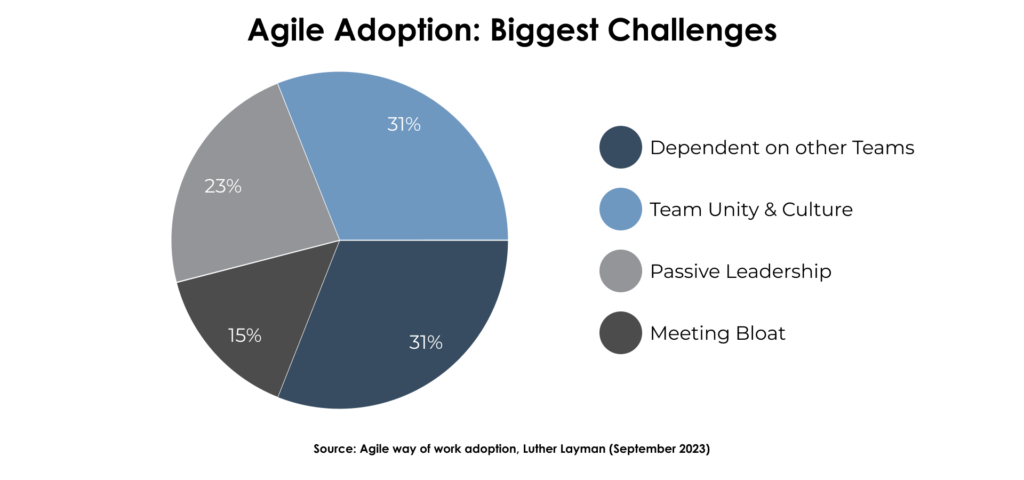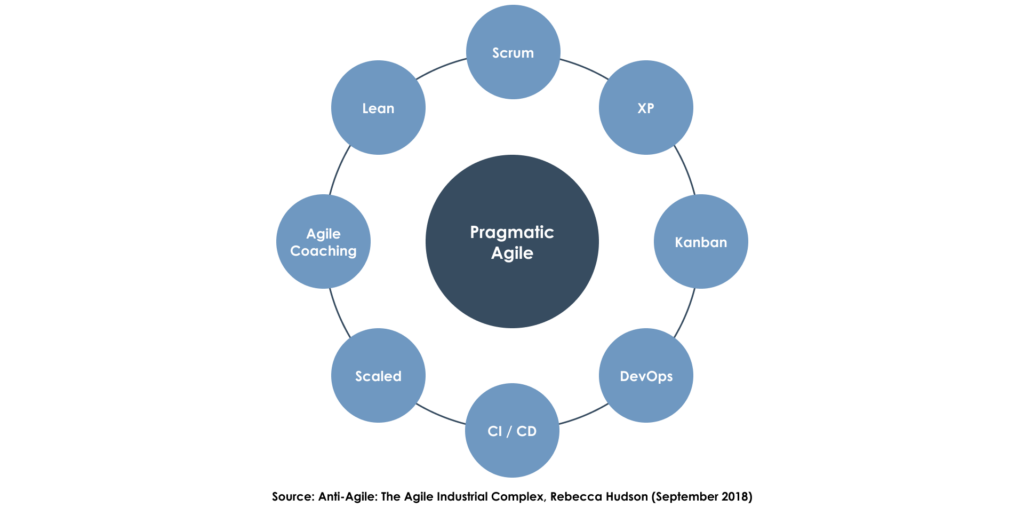Media
Practical Agility for Enterprises

Before we get to practical agility, we must agree on what an Agile way of working means. Agile is a term that is widely used within the IT world, which broadly describes a type of methodology that teams follow. The founding story of agile started in 2001, 17 software engineers met in Utah USA to form an opinion on what is the best software development process to follow, they created the Agile Manifesto which I quote below:
- Individuals and interactions over processes and tools
- Working software over comprehensive documentation
- Customer collaboration over contract negotiation
- Responding to change over following a plan
However, since 2001, Agility has lost its meaning creating distrust, apprehension and some organisations completely rejecting practices of so called “Agile Experts” according to one of the founding members of Agile, Dave Thomas. Furthermore if you want a practical example of Agility in organisations, I suggest this article “What Agile really means” by Pragmatic Engineer.
My definition of Practical Agility; “Shifting the mindset and attitudes of a company AND employees to create a culture of delivering constant, incremental, value to customers”.
How to do something in an Agile way if you want to start TODAY.
- Find out where you are.
- Take a small step towards the goal.
- Adjust your understanding based on what you learned.
- Repeat that process!
- How – if you are faced with two choices of the same value – choose the one that makes the future changes EASIER!
The challenges that enterprises typically face when trying to adopt Agile practices
I conducted an online survey across our 400 strong team (local and international employees) and asked questions on, “What is preventing supercharging our Agile way of work?” The results where overwhelming with the top 2 responses tied at 31%, were Culture and Dependencies on other teams which ruin their ability to adopt agile ways of working. Notably, Passive leadership at 23% and Meeting bloat at 15% finished it off, but all are very important.

- Dependencies – silos are very real in certain organisation, think about processes and how you can create and remove impediments to your team. A real-world example would be our payment teams not being able to test the end-to-end checkout process because we did not give them credit cards – a stupid blocker to have – if we gave them cards we could have just ensured we have audits in place and problem solved!
- Passive leaderships – not having a clear roadmap and not providing clarity of purpose to your teams is detrimental to creating Agility in teams – how do you achieve something which is vague and unclear?
- Meeting bloat – I always audit the meetings in my teams and ask this questions “are we providing value and meeting the sprint goal with this session?” but further to that you can actually calculate the cost of a meeting with this tool from HBR. Not all meetings are bad but, becoming aware of the cost of meetings in your personal capacity, you can become ruthlessly more efficient and productive as an organisation.
Why practical agility is crucial for enterprises in today's dynamic business environment
If we look back to the true meaning of Agile, at least, my true meaning of Agile, we have to create a culture of delivering constant, incremental, value to customers. We live in a fast-paced world, and not responding to change or to competitors can lead to losing market share and relevance. An example of how adapting to change lead to increased ROI is Checkers Sixty60 – many times we look at others and try to copy instead of forging our own unique path through playing to your strengths. Another example of why we must adapt to change is with the rapid rise of A.I. where we are already seeing the impact of A.I. in academia namely students can submit original works, which have been completely fabricated.
Successful adaptation of Agile Methodologies
Collaboration amongst the team enhances Practical Agility. Assigning TASKS ruins collaboration, Enterprises run into the problem of using tools such as JIRA or Linear and assigning team members tasks. Instead of driving collaboration and collective ownership of team goals, team members only do what they were ASSIGNED to do.
I am not suggesting bringing back stickies but the physical nature of it, combined with in person stand ups, which I know is sometimes just impossible for some organisations. Stickies created a team unity which is not easily replicated online.
People forget to remind everyone why we are doing the change. When Agile projects fail, they often don’t remind teams why they are doing such a change in business, and teams go back to old habits which creates even more resistance. This leads to what I call the “Broken Record effect”.
Taking extreme ownership is another factor to consider, especially when things go wrong and trust me, they do, protect the team from negative consequences but always give fair and honest feedback so the team can improve.
4 Key factors that contribute to successful adaptation of agile methodologies:
- Team led / Empowered teams and people that are coachable and have a level of autonomy.
- Adding Value through delivering working software to customers regularly.
- Recognition and reinforcement through ensuring people at the centre of everything you do.
- Reviewing to allow for continuous improvement and learning.
Measuring the success of practical agility within an enterprise
When I want to measure whether there is practical agility within an enterprise, I first ask this question “Are you delivering working and valuable software to your customers after each sprint?”. You have to ensure that you Deliver working software EVERY Sprint. If you are using SCRUM, you have to ALWAYS have Sprint Goals. The Agile Gardener stated “if you don’t have a sprint goal you are NOT DOING SCRUM!” Did you know JIRA can provide you real time insights during your daily scrum? It provides a wealth of data such as sprint report, velocity and burndown chart where you can track your progress as a team! There is a wealth of resources that can assist measuring success; however, you just need to find the one that works the best for you and your team.
Common challenges or resistance points that enterprises face when transitioning to practical agility
To quote a YouTube commentator “AGILE INDUSTRIAL COMPLEX (AIC) has become a cult. As a leader, influencer or team member, you have to speak up and choose the model that works best for YOU. Rebecca Hudson summarises what the AIC has created “I’ve had roles where I’ve been put the position of trying to coach teams in ways of working which they had no input into, and neither wanted nor (in my opinion) needed.” What we need to do is listen to our teams and what will best fit for their needs not just outright adopt and model and give it to our teams to implement.

Strategies and frameworks that are effective in scaling agility
Lightwork frameworks is a good framework which basically comes down to, don’t overcomplicate your journey as an organisation, there is a myriad of content online and on YouTube that will super charge your agile journey try one thing, test, throw away what doesn’t work and implement what does.
Have an Agile mindset. It takes incredible courage as a leader to change your ways of work. Audit yourself first and lead the change from the front.
If you don’t know what methodology you want to adopt START with The Scrum Guide, it is only a few pages long, however we find in organisations we over complicate events and don’t realise that scrum is founded on principles of lean thinking which is reducing waste and Empiricism as well as knowledge comes from experience! Keep it simple. It has a great balance of team autonomy and providing visibility to leadership.
Lessons learned from my own journey toward practical agility
Team culture is everything, I would rather have a team full of B’s and C’s who are teachable and coachable to become A’s, than a star player who disrupts and cannot play nice with their team members.
I use Reetro.io, which allows for teams to quickly structure feedback, timers to timeboxing feedback, run quick polls and send out action items via PDF, mail, XLS etc. A very fun tool to use especially if you have an offshore team or working in a hybrid manner.
About Luther Layman
Luther Layman is a Senior Scrum Master at CyberPro Consulting (Pty) Ltd, currently deployed to Woolworths within the Dash App Team, where his focus is driving practical agile software development techniques.
He started his career at Vodacom as part of discover graduate programme where he got exposed to projects in RPA and Chatbots (Tobi). His career path started a project administrator and then transitioning into a business analyst almost 10 years ago. Through those projects he got exposed to Agile methodologies like SCRUM and KANBAN and practices where he took an interest in Scrum Master career path after exposure to the role. He was there as a founding member of Vodacom’s transformation to agile way of work where they started experimenting with the SAFe Model to scale agile across a number of different teams (A.I, RPA and Machine Learning).
The qualifications Luther has are: SAFe® Agilest Certification (Scrum Master) from APMG Scaled Agile Inc, Agile Project Manager practitioner from APMG International and Founding member of Vodacom’s Transformation from Waterfall to Agile way of working.
We can help you grow your business

Driven by a commitment to client satisfaction, collaboration, and cutting-edge solutions.
Years Experience

Delivering excellence through decades of expertise, innovation, and trusted solutions.
